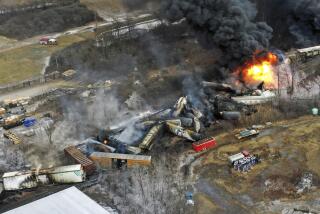Consumer Groups Blame Ford for Tire Accidents
Two consumer groups said Wednesday that Ford Motor Co. is primarily to blame for the accidents involving Firestone tires and Ford Explorers that have killed scores of people.
Public Citizen and Safetyforum.com, both Washington-area based consumer groups, issued a report saying that the tires were badly designed and manufactured by tire maker Bridgestone/Firestone, but that the tire design was dictated by Ford, which also designed an unstable vehicle in the Explorer, the country’s best-selling sport-utility vehicle.
“At its core, the Ford-Firestone tragedy was largely the responsibility of Ford Motor Co.,” Public Citizen President Joan Claybrook said at a news conference in Washington.
“First, Ford designed a vehicle that was prone to rolling over--the Bronco II--and the company refused to fix it,” Claybrook said. Ford then replaced the Bronco with the Explorer using a “virtually identical design theme,” she said.
Ford also determined the specifications for the tires it ordered from Bridgestone/Firestone, in effect putting a less-robust passenger car tire on a truck and subjecting it to unreasonable stress, and recommended an inadequately low tire pressure, further prompting the tires to shred and lose their treads, the report said.
Ford issued a terse two-sentence statement in response to the news conference. “We continue to work closely with the National Highway Traffic Safety Administration,” said Mike Vaughn, spokesman for safety affairs. “Any group with information should be sharing it with NHTSA.”
The report said Bridgestone/Firestone is to blame as well, agreeing to produce an inadequate tire, using faulty production and quality-control techniques, and not acting to correct errors when it knew the tires had a dangerous tendency to shred.
Last August Firestone recalled all 15-inch ATX tires, and 15-inch Wilderness AT tires made at its Decatur, Ill., plant because of their involvement in accidents in which Ford Explorers lost their treads and spun out of control, often rolling over.
So far 184 deaths have been linked to Explorer/Firestone accidents, including 29 that were tallied from Safetyforum.com’s litigation database but not reported by Ford or Firestone, said Ralph Hoar, president of Safetyforum.com.
The nonrecalled Wilderness AT tires are of the same design and thus have the same defects, so Ford and Firestone should move quickly to get additional “fatally flawed tires off the highway to avoid another summer of endless reports that another Firestone tire has failed, another Ford Explorer has rolled over and more people have died,” Hoar said.
The groups called on Ford to carry out owner-notification and public-information programs to warn about what they called the continuing dangers of the Explorer’s tendency to flip over. They also urged all auto makers to build their SUVs smaller and lower to make them less rollover prone.
They asked NHTSA to update its tire-safety and roof-crush standards, and issue rollover standards based on actual testing in addition to mathematical simulations. They also repeated their call to Firestone to recall all Wilderness AT tires, including those made at plants other than Decatur. Claybrook estimated there are about 10 million of those tires on the road.
Bridgestone/Firestone said it stands behind its own root-cause analysis and that there is no need to expand the tire recall.
“We believe the data supports that the August recall is more than adequate to protect the public,” spokesperson Jill Bratina said.
Bratina would not comment on the groups’ report concentrating blame on Ford. “We’ve always said vehicles and tires are integrated systems,” she said. “We’ve focused on the tires because that’s our area of expertise.”
She did, however, dispute a main contention of the report by the safety groups, which cited a chart from Firestone’s own root-cause report noting some cracking in tires produced in plants other than Decatur.
“Our report says that chart should be used with caution,” Bratina said. “There are a lot of confounding variables” because some tires had been run only short distances whereas others had run more than 130,000 miles, and it wasn’t clear if they had been used primarily on highways or city streets, or at what inflation.
Although the safety advocates claim non-Decatur tires also show high levels of failure, Bridgestone/Firestone said there were only three damage claims recorded out of 1.4 million tires made in Joliette, Quebec, and 31 claims out of 3.3 million tires made in Wilson, N.C., compared with 165 claims out of 3.4 million tires made in Decatur.
But Tab Turner, an attorney who specializes in auto-safety litigation and who participated in the study, said heat is a main factor in the tread separations, and in studying tires that were distributed to southern, hotter states, the numbers show otherwise: Six out of 10 tires from Joliette showed separation at the edges of the steel belts; five out of 10 from Wilson had such belt-edge separation, whereas only three of 10 from Decatur showed separation.
Also on Wednesday, Bridgestone/Firestone disclosed it is holding settlement talks with attorneys representing hundreds of victims of accidents involving its tires. Turner, who is representing many of the victims, said Ford has refused to be involved in the talks. A spokesman for Ford did not return calls for comment.
Turner, who has settled several tire lawsuits for more than $100 million, said the talks are broad and no details for a settlement have been discussed.
*
Jones reported from Detroit and Kaplan from Washington. Associated Press was also used in compiling this report.






